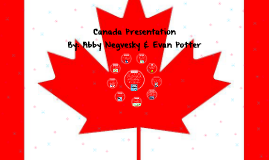Canada Presentation
Transcript: The Canadian government is a Constitutional Monarchy and Parliamentary Democracy with 443 members in its legislature. Executive elections are held every 5 years, the last of which occurred in 2015. Canada's top economic imports are Cars ($26.9B), Crude Petroleum ($21B), Vehicle Parts ($20.4B), Refined Petroleum ($17.9B) and Delivery Trucks ($12.7B). The top economic export destinations of Canada are the United States ($331B), China ($18B), the United Kingdom ($10.6B), Japan ($10.2B) and Mexico ($7.81B). Region Q: How can the relationship between the United States and Canada be summarized? A: Canada and the United States have one of the world's unique relationships: two sovereign states, occupying the bulk of North America and sharing the world's longest undefended border, each reliant on the other for trade, continental security and prosperity. Q: Describe how Canada plays an important role in the global community? (Economic) A: Atlantic Canada is traditionally a trader and the link by sea for many of Canada’s international relationships. As the home of a large part of the military, it has long played a key role in Canada’s global activities. Nova Scotia is also home to the Pearson Peacekeeping Center, the institution which supports Canada's contribution to international peace and security. One of the most controversial environmental issues in Canada is the extremely high-carbon process of extracting oilsands deposits found in Northern Alberta. Canada is the single largest source of greenhouse gas emissions (responsible for climate change) is Canada's oil industry. Other examples are Deforestation, Dredging, Drift-net fishing, Noxious substances, Poaching, Pollution, Extracting natural resources. Cultural diversity, Conflicts (natural & human), Over population of animals, Climate and Landforms. Place Location Human characteristics in Canada are not unique they are very similar to the religion of Christianity and Islam, the style of architecture, or the constitutional monarchy political system to Britain, New Zealand, Denmark and the Netherlands. Canada's highest point is Mt. Logan (19,551ft) located in the province of Yukon. Canada's lowest point is the Great Slave Lake (2,015ft below sea level) located in the Northwest Territories. Info. Item #2 Q: Why did Quebec and Ontario develop as Canada's economic heart? A: Quebec and Ontario border the Great Lakes and the St. Lawrence River which opens a gateway for the transportation of PIG-people, ideas, & goods. Also the positions of the provinces is a big part of the thriving economy. The majority of the country has a cold or even severely cold winter climate. Southern areas are warm in the summer. Canada is sparsely populated but the majority lives near the southern boarder. Most of Canada's land territory is dominated by forest, tundra, and the Rocky Mountains. Canadian culture is heavily influenced by its conquerors which include the French, the British , and a bit of the indigenous cultures. Canada has also seen immigrants from Russia, China, Italy, Germany, Netherlands, and other nations. This is why Canadian's have many different cultures and ways of life. Info. Item #5 Info. Item #1 Info. Item #3 Q: Describe why many of the mineral deposits and oil reserves in Nunavut, Yukon, and the Northwest Territories have not been developed? A: The natural factor limiting development of the West is the availability of water, land, mineral deposits, natural vegetation. Also many of the mineral deposits and oil reserves in the Yukon and Northwest Territories have not been developed because environmental laws prohibiting mining. Q: How did the Great Lakes and the St. Lawrence River affect the economic development of Ontario and Quebec? A:Great Lakes and St. Lawrence River have been utilized as a means of transportation. Great Lakes cities were founded as trading posts along a vast marine highway that facilitated commerce in an era pre-dating railroads and highways. This relationship to the water has enabled the region to thrive and today, the Great Lakes-St. Lawrence region is the industrial and agricultural heartland of both the United States and Canada. Info. Item #4 Canada is a country in the northern half of North America. Its ten provinces and three territories extend from the Atlantic to the Pacific and northward into the Arctic Ocean, covering 9.98 million square kilometers, making it the world's second-largest country by total area and the fourth-largest country by land area.About four-fifths of the country's population of 36 million people is urbanized and live near the southern border. Its capital is Ottawa, its largest metropolis is Toronto; other major urban areas include Montreal, Vancouver, Calgary, Edmonton, Quebec City, Winnipeg and Hamilton. H-E-I Economy & Government Canada Presentation By: Abby Negvesky & Evan Potter

















